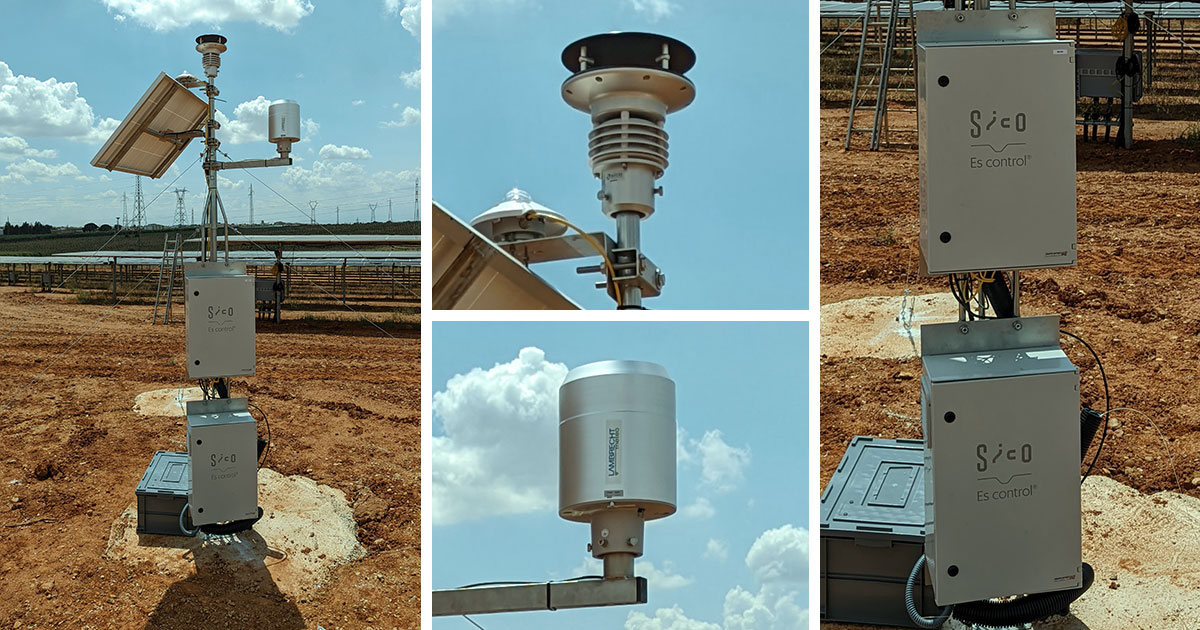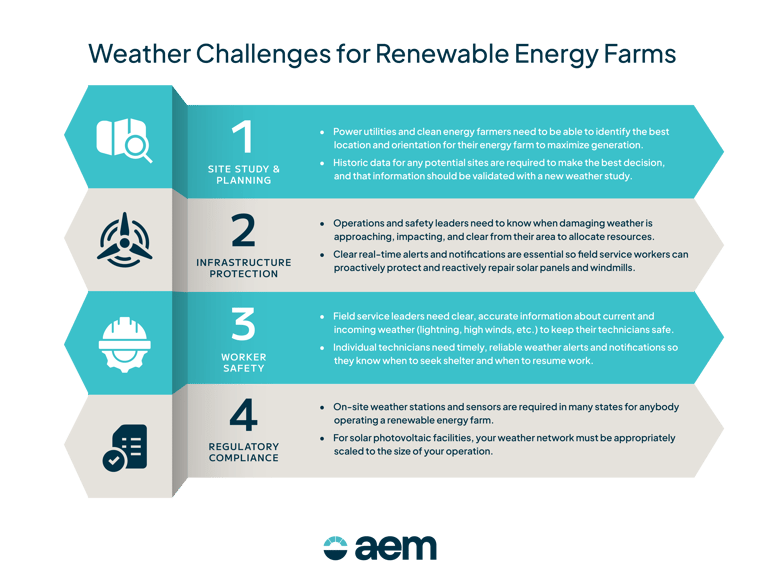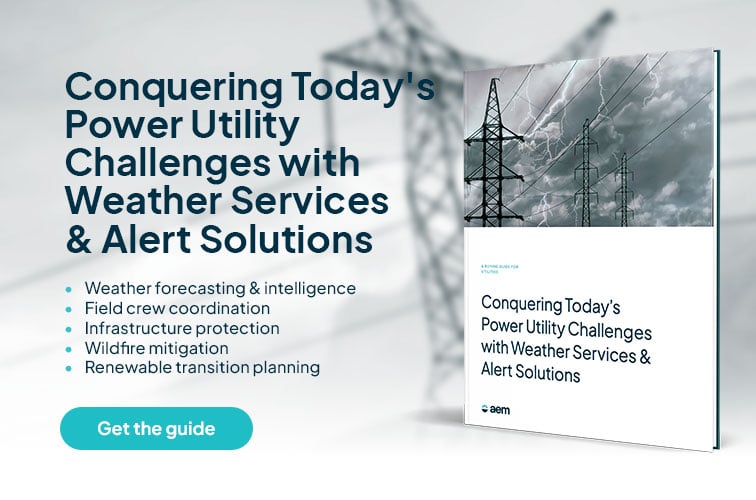
As power and energy utilities across the world shift away from traditional sources of energy towards more sustainable, renewable alternatives such as wind and solar, weather monitoring has become increasingly important. Good quality historic and real-time data are essential for a renewables operation, enabling informed decisions around site planning, resource deployment, and infrastructure management.
Moving forward, we’ll explore…
- Why weather monitoring is key to the renewable energy transition
- The components of a weather monitoring system for a solar or wind farm
- How weather data can inform and maximize renewable farm planning
- The importance of continuous weather monitoring at renewable generation sites
- What to look for in a weather partner to support your renewables initiatives
The importance of weather monitoring for renewable energy farms
For utilities making an investment in renewable energy farms, weather monitoring is a vital tool for the planning and operation of their facilities. By understanding the weather patterns and fluctuations in their area, these farms can optimize their performance and protect their infrastructure from extreme weather conditions.
Monitoring can help identify ideal times for maintenance, ensuring that energy farms are operating at their best capacity. Furthermore, weather monitoring gives farmers the ability to protect their facilities from incoming major weather events, such as hurricanes, heatwaves, or hail, which could cause significant damage. All in all, weather monitoring plays a substantial role in renewable energy farms, making it a key investment for any utilities or businesses operating or planning to operate solar or wind farms.
What components make up a weather monitoring system for a renewable farm?
A professional weather station is the go-to device for measuring temperature, humidity, air pressure, and rainfall at a renewable energy farm. For wind farms, measuring wind speed and direction with a high degree of accuracy is especially important. In solar applications, monitoring U.V. radiation is also key to protecting infrastructure and getting the most out of the site.
Lightning detection sensors can alert safety and operations teams to incoming storms, helping them to prepare for potential damage and ensuring technicians remain clear of the area until it's safe for them to return for repairs and reactive maintenance.
In order to view the data from those sensors and turn it into action, solar farm managers also need weather software that makes real-time data from the field highly visual, provides meaningful context by comparing it with historic data, and notification capabilities that let field service and operations leaders know when a specific response is required.
With those components in place, a renewable farm can gather important weather data in real-time, allowing them to make informed decisions to ensure the maximum efficiency of the farm's system while keeping workers safe.
Weather monitoring for energy farm planning
Weather monitoring and data study are fundamental to site identification and scoring for renewable energy farms. Your understanding of hyperlocal weather conditions plays a significant role in identifying the ideal placement for infrastructure, ultimately leading to the optimization of energy production and renewable farm potential.
That same data will also uncover unique quirks and weather challenges specific to each site that need to be taken into account from the beginning of the process. In this way, energy providers can ensure their infrastructure is built in places where it can withstand different weather conditions and achieve maximum efficiency. In short, weather monitoring helps identify where to place infrastructure, making it a crucial aspect in energy farm planning.
Continuous weather monitoring for solar and wind farms
Continuous weather monitoring is essential for solar and wind farms, as damage caused by weather can greatly impact the output of these facilities. That same weather also poses a major safety threat to the field service and operational maintenance professionals responsible for protecting and repairing generation equipment. By utilizing sophisticated monitoring tools and software, renewable energy providers can protect both their equipment and their workers, ensuring optimal performance and outstanding safety.
In many areas, continuous monitoring is a matter of regulatory compliance at renewable energy sites, making an on-site weather station an absolute must.
Real-time weather information from the field can also be combined with historic weather data to provide a complete picture of major weather events. For example, if a sensor at a wind farm detects a major windstorm, maintenance and safety professionals can also check lightning data from that same storm before responding to the site to get a better understanding of what type of damage may have occurred.
This kind of technology not only protects the infrastructure but also the businesses' bottom line, making it critical to the success of any renewable energy operation. As solar panels and generation windmills become increasingly commonplace, ongoing weather study will help operations crews uncover best practices for maintenance and safety.
What to look for in a weather monitoring solution for renewables
As the demand for renewable energy grows, it's becoming increasingly important to consider extreme weather and climate variability as part of your transition strategy. When searching for a weather partner, there are a few key things to consider. The first is data accuracy – you need to feel confident that the information you're receiving is reliable and up-to-date.
Additionally, rugged equipment is essential to withstand harsh weather conditions. But perhaps most important is finding a solution backed by real meteorologists and scientists. With their expertise, you can be sure that you're receiving the most accurate and actionable information possible. Investing in a high-quality weather monitoring solution can provide significant benefits for renewable energy production.
How your weather network can strengthen your renewables initiative over time
Understanding historic and evolving weather patterns in your region is crucial to building a successful renewable initiative. With weather variation affecting everything from wind power to solar energy, hyperlocal data can help optimize your renewable resources to target maximum efficiency. By tracking patterns over time, your weather network can provide valuable insights into optimal times for energy production and the best ways to protect your equipment from extreme weather conditions.
A comprehensive weather monitoring solution should track long-term climate trends as well as short-term fluctuations in order to provide the necessary insight for anticipating production shortfalls at renewable farms. Additionally, the right weather network can also enable predictive maintenance on your wind and solar farm components for greater reliability and enhanced efficiency.
If you’re looking to get started with renewables at your utility or if you’re enhancing an existing system, having an accurate overview of your site's environmental conditions is essential. Consider investing in a weather monitoring solution that is tailored to fit your specific onsite conditions and needs – it’ll pay off in the long run! If you have any questions or concerns about setting up optimal weather monitoring for your renewable energy facility, don't hesitate to talk to an AEM utilities expert today.
.jpg?width=756&height=187&name=Q3_PartnerNewsletter_Banner_4%20(1).jpg)




